Minted in 1793 to 1857, the half cent is the smallest denomination ever minted in the United States. It came in different design varieties, including the Liberty Cap Half Cent that was issued from 1793 to 1797. It came in two different versions…READ MORE
The Draped Bust Half Cent was born when Chief Engraver Robert Scot created a new design of the half cent in 1800. From 1800 to 1808, with the exception of 1801, the coins were produced. In this design, Liberty is amply proportioned and is wearing drapery around her bust. A ribbon tied her hair up. It is believed…READ MORE
The Classic Head Half Cent is an early copper half cent that was produced from 1809 to 1836. It was designed by engraver John Reich and showed Liberty in a different style. Compared to the previous designs for the denomination, the Classic Head Half Cent was issued for a longer period. The scope of the series was…READ MORE
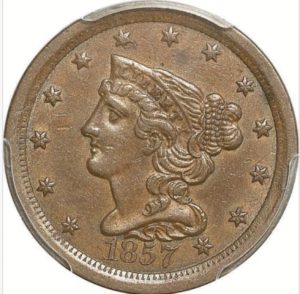
One of the first regular issue coins the US Mint produced after its establishment in 1792 was the half cent, the smallest US coin denomination ever minted. It was produced from 1793 until 1857, and sported five designs throughout its run. The last design being the Braided Hair Half Cent by Mint Engraver Christian Gobrecht…READ MORE
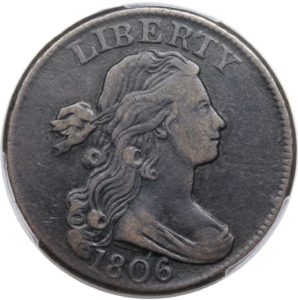
During the early days of the American coinage, the one cent denomination went through a series of design changes. In a span of 5 years, four different designs were created. It was only when the Draped Bust design was introduced in 1796 that the design reached a measure of satisfaction and was continued in use until 1807. For this reason, the Draped Bust Cents experienced high…READ MORE
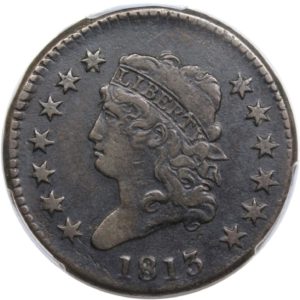
The design of the Classic Head Cents appeared in 1808, the 5th redesign in just 15 years of production. The design known as the Classic Head Cent was based on the design of previous large cents but the resemblance is almost negligible. The same design was introduced for the half cent in 1809 and later for the silver…READ MORE
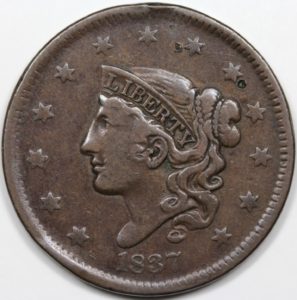
The Coronet Cents are the type of cent issued from 1816 to 1839 by the Philadelphia Mint. Its design, the Coronet Large Cent, was sometimes nicknamed Matron Head. This was one of two similar designs that went through several variations. By 1839, the profile of Liberty herself was altered. For each of the year that the Coronet Cents were produced, at least one…READ MORE
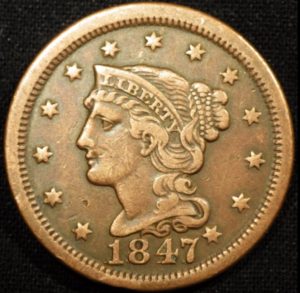
The public wasn’t always so kind to the large cent design. Criticism has been hurled its way since it first appeared in 1793 to last design in the series, the Braided Hair Cent. It was criticism that prompted another redesign of the large cent – the last – and this time Chief Engraver Christian Gobrecht decided to give Liberty a much more youthful appearance…READ MORE
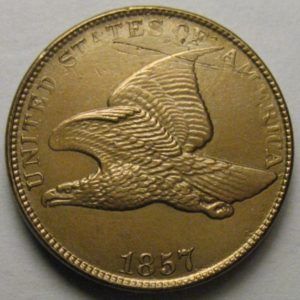
The large cent design produced since 1793 was not only unpopular, it was also expensive to produce. This was known since the early 1850s, but the last large cent coin with Braided Hair design lasted until 1857. But a replacement, the Flying Eagle cent, was already created in 1856, designed by Chief Engraver James B. Longacre and circulated in 1857 and 1858…READ MORE
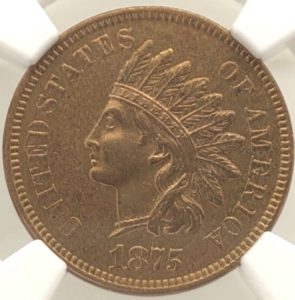
With its high relief design, the Flying Eagle cent was difficult to strike. Owing also to its unpopularity, Mint Engraver James B. Longacre was asked for redesigns and the eventual winner was the Indian Head obverse and laurel wreath reverse combination. It is said that Mint Director James Ross Snowden preferred the design, known as Indian Head design, because it had the lowest relief and would therefore…READ MORE
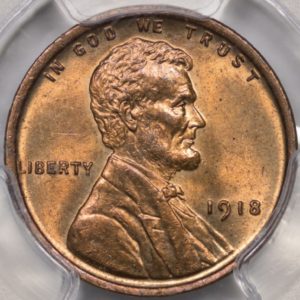
There was a tradition of not putting a portrait of an actual figure in US currency. That practice lasted for years until 1909, with the release of the Lincoln Cent on the centennial of Abraham Lincoln’s birth. The idea of using a public figure on a US coin is nothing new. Mint Director James Ross Snowden floated the idea of putting Columbus on the cent, but eventually settled with the Indian Head design…READ MORE
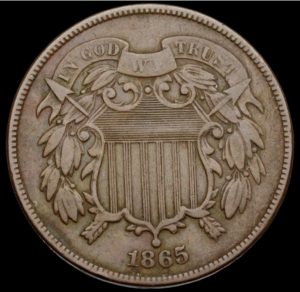
Economic turmoil during the American Civil War caused the public to hoard coins leading them to vanish from circulation. To fill the gap, some entrepreneurs came up with bronze cent-sized private tokens. The use of such emergency pieces didn’t escape the notice of the US Mint. The Shield Two Cents was the Mint’s response to fix the coin shortage problem…READ MORE
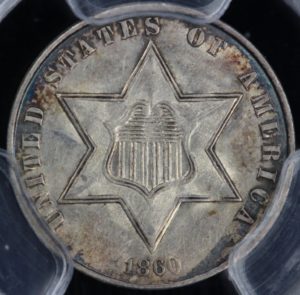
A couple of circumstances led to the creation of Three Cent Silver in 1851. First, gold was discovered in Sutter’s Mill in California in 1848. The increased mining of gold affected US coinage as its value depressed compared to silver. As a result, silver coins were hoarded and melted since they were worth more in that state. That, and the fact that fewer people were taking silver to the Mint for transformation into coinage limited the production of silver coins…READ MORE
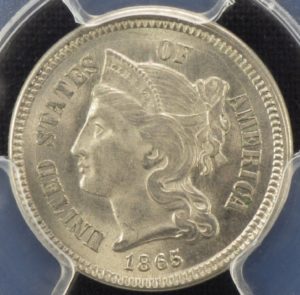
Also known as the copper-nickel-three-cent piece or three-cent nickel piece, the three cent nickels are one of the US coins with a brief part in mintage history. It was only minted for 24 years before it was discontinued. The good news is 12 of those 24 different dates are considered rare and more valuable which spells good news…READ MORE
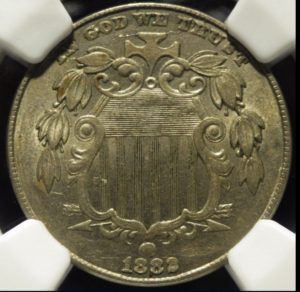
Copper-nickel is the alloy of choice for American nickels made today, and the Shield Nickel created after the Civil War is the first five-cent coin to be struck with such a combination. It is also the first to be called a “nickel” since five-cent pieces, which were made of silver, were referred to as half dimes. Coin hoarding was at a high during the war, leading coins to…READ MORE
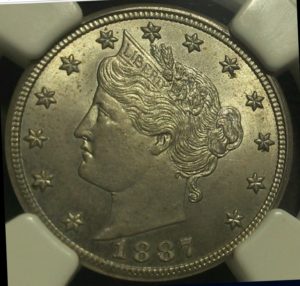
In the early 1880s, a replacement was already being sought for the Shield Nickel which had been in production since 1866. The Shield Design proved difficult to strike and the US Mint was looking for solutions. Joseph Wharton, an industrialist and nickel mine owner, was lobbying for the bronze cent to be made in copper-nickel. Mint Superintendent Archibald Loudon Snowden then asked…READ MORE
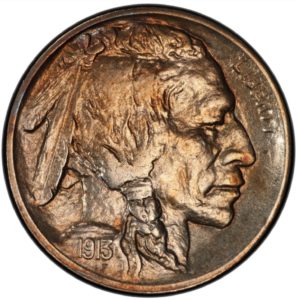
During Theodore Roosevelt’s presidency, five US coins received new designs. He left office in 1909, but the desire to produce more inspiring coin designs was still alive. That was made further possible with the Coinage Act of 1890 that allowed designs to be changed after 25 years. The particular coin up for a redesign was the Liberty Head Nickel in production since 1883…READ MORE
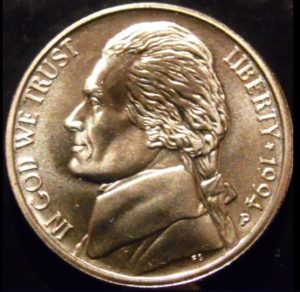
Since it was introduced in the United States in 1983, the Jefferson Nickel has been the longest running five cent denomination series. It was struck by the United States Mint to replace the Buffalo nickel. The coin’s continuity may have been interrupted briefly by the emergency of the Second World War but is still minted to this day. Jefferson Nickel, as the name suggests…READ MORE
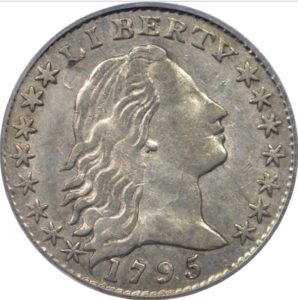
Early Half Dimes. Also referred to as half disme, Early Half Dimes are five cent U.S. coins made of silver. They were first made in 1792, a year earlier than when the first United States Mint opened for business. Still, there were considered official coins of the country. Early Half Dimes were rumored to be made from silverware. Due to President George Washington’s eagerness for…READ MORE
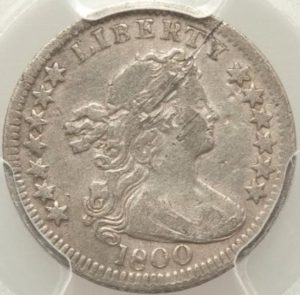
Early Half Dimes. Also referred to as half disme, Early Half Dimes are five cent U.S. coins made of silver. They were first made in 1792, a year earlier than when the first United States Mint opened for business. Still, there were considered official coins of the country. Early Half Dimes were rumored to be made from silverware. Due to President George Washington’s eagerness for…READ MORE
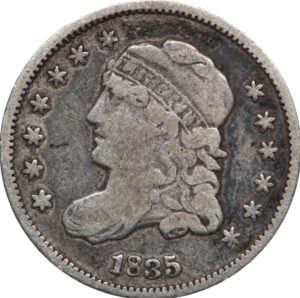
Early Half Dimes. Also referred to as half disme, Early Half Dimes are five cent U.S. coins made of silver. They were first made in 1792, a year earlier than when the first United States Mint opened for business. Still, there were considered official coins of the country. Early Half Dimes were rumored to be made from silverware. Due to President George Washington’s eagerness for…READ MORE
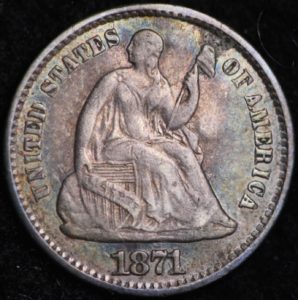
For the budget-minded or beginner collector, Seated Liberty Half Dime provides an interesting series to collect, with the exception of the 1870S since only one is known to exist today. Designed by Christian Gobrecht, the No Stars Obverse variety of the Seated Liberty Half Dime was minted between 1837 and 1838. Those produced in Philadelphia has no mint mark, while those produced in New Orleans bore a mint mark…READ MORE
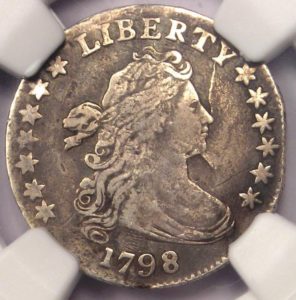
Early Dimes – Draped Bust and Capped Bust. The dime may be an essential part of the U.S. decimal coinage system but it was one of the last coins that were issued by the U.S. Mint when the first operations began. This is why, by the time the Draped Bust made its debut, copper cents and half cents have already been minted for 3 years, silver dollars and half dollars and half dimes for two years, and two gold coins—half eagle and the eagle—have been struck for a year…READ MORE
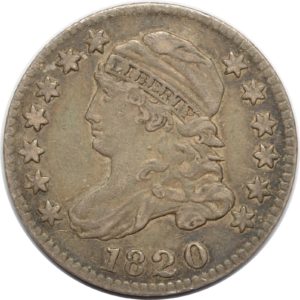
Early Dimes – Draped Bust and Capped Bust. The dime may be an essential part of the U.S. decimal coinage system but it was one of the last coins that were issued by the U.S. Mint when the first operations began. This is why, by the time the Draped Bust made its debut, copper cents and half cents have already been minted for 3 years, silver dollars and half dollars and half dimes for two years, and two gold coins—half eagle and the eagle—have been struck for a year…READ MORE
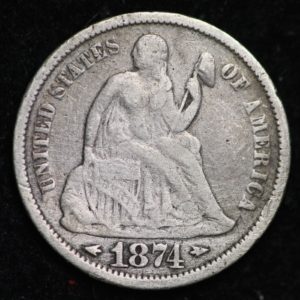
The Seated Liberty design was the standard in American coinage for decades, including dimes. Although it remained in circulation for more than 50 years, calls for its replacement came in the 1880s when it was nearing the half century mark. It first appeared in 1837, the end of Andrew Jackson’s presidency, and lasted until 1891, the time of Benjamin Harrison’s presidency. With more than 50 years…READ MORE
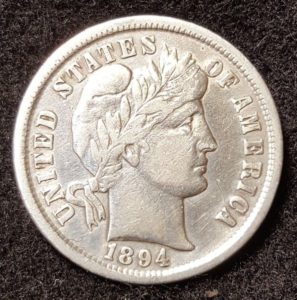
Issued between the early 1890s to the early 1910s, the Barber Dime was the replacement of the Seated Liberty design used since the 1830s. Calls to change the Seated Liberty coin rang loudly since 1879, however change didn’t come until 1892. The Barber coins were in circulation until 1916. More than half a billion Barber dimes were…READ MORE
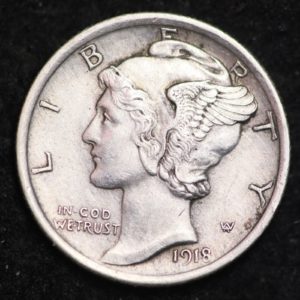
Despite being in its name, the Mercury dime does not feature the god Mercury at all. The portrait on the obverse is that of Liberty wearing a Phyrgian cap. But the term Mercury was used to describe the coin early on and the name stuck. The Mercury coin was first minted in 1916…READ MORE
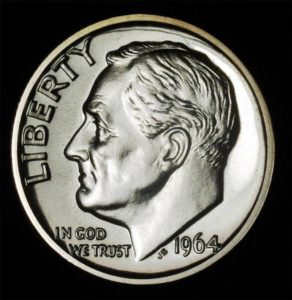
The Roosevelt dime replaced the Mercury dime, which was issued from 1916 to 1945. Authorized to be made soon after the passing of Franklin D. Roosevelt, it first circulated in 1946 and remains the dime design to this day. Since the Roosevelt coin doesn’t feature rare dates…READ MORE
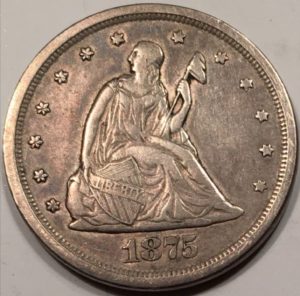
The US twenty cent piece was struck for only three years, from 1875 to 1878. The release of the coin was cause for much confusion as it closely resembled a quarter. As such, there was little demand for the coin which led to it being abolished in 1878…READ MORE
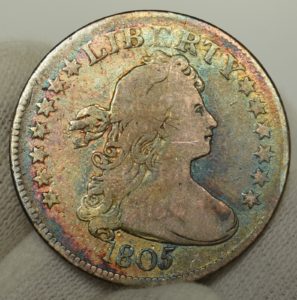
The Early Quarters – Draped Bust and Capped Bust. The year is 1791 and US Congress has just passed a joint resolution calling for the creation of a national mint. A year later, its establishment was authorized by the Coinage Act of 1792. It took two years before coins were struck, with the Flowing Hair dollar being the first coin produced. So much was the dislike for the coin that a new design was called for…READ MORE
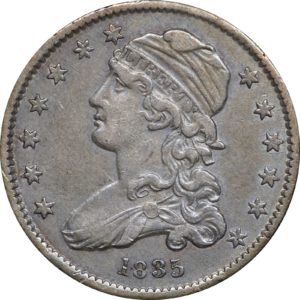
The Early Quarters – Draped Bust and Capped Bust. The year is 1791 and US Congress has just passed a joint resolution calling for the creation of a national mint. A year later, its establishment was authorized by the Coinage Act of 1792. It took two years before coins were struck, with the Flowing Hair dollar being the first coin produced. So much was the dislike for the coin that a new design was called for…READ MORE
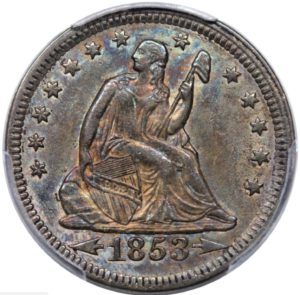
Minted over 50 years, the Seated Liberty Quarter is one of the easier coin series to collect. But a rare find would be those that come with a CC mint mark. In fact, such coins rarely fail to make any collector’s and dealer’s pulse to quicken. It draws attention big time. The coinage design of the Seated Liberty is the longest-running…READ MORE
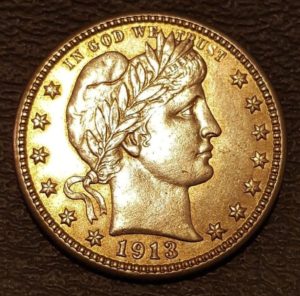
The 1890’s were a major period of transition for the United States of America. The country was rife with an economic depression and unions were attempting to find their role in the new industrial society. Major events and developments were unfolding in the areas of industry, art, music, culture, and politics. This was, in every sense of the word, a stepping stone from the world of the 19th century to the world of the 20th. This is…READ MORE
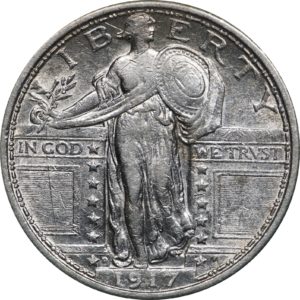
In 1916, the atmosphere in the United States of America was tense, to say the least. WWI was raging fiercely and the country was in a politically charged state. As such, the federal government was highly interested in a coin that stood for the increased desire for national self-interest and protection. Ultimately, they decided to mint such a coin to embody this desire in the public consciousness. This lead to the…READ MORE
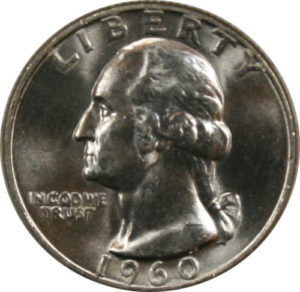
In 1931, the United States of America was in a dark pit of economic desperation. The Great Depression had caused a great deal of financial woe for nearly everyone in the country and the times seemed as bleak as they were poor. However, 1932 was the 200th anniversary of the birth of George Washington and the federal government decided this was an event to be celebrated with full force. At the behest of the Treasury Department, the government…READ MORE
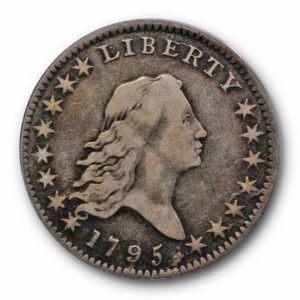
Early Half Dollars – Flowing Hair, Draped Bust, and Capped Bust. The Silver Half Dollar began circulation in 1794 with the Flowing Hair design. Congress wanted a coin that would be “emblematic of liberty”. The Flowing Hair silver half dollar gets its name directly from the imagery on the coin’s face. The half dollar, was designed by Chief Engraver at the time, Robert Scot, and features a young woman with flowing hair that represents freedom. Due to the…READ MORE
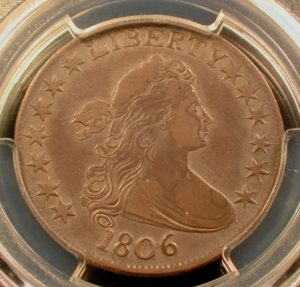
Early Half Dollars – Flowing Hair, Draped Bust, and Capped Bust. The Silver Half Dollar began circulation in 1794 with the Flowing Hair design. Congress wanted a coin that would be “emblematic of liberty”. The Flowing Hair silver half dollar gets its name directly from the imagery on the coin’s face. The half dollar, was designed by Chief Engraver at the time, Robert Scot, and features a young woman with flowing hair that represents freedom. Due to the…READ MORE
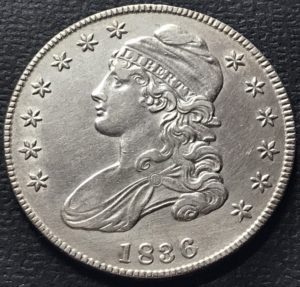
Early Half Dollars – Flowing Hair, Draped Bust, and Capped Bust. The Silver Half Dollar began circulation in 1794 with the Flowing Hair design. Congress wanted a coin that would be “emblematic of liberty”. The Flowing Hair silver half dollar gets its name directly from the imagery on the coin’s face. The half dollar, was designed by Chief Engraver at the time, Robert Scot, and features a young woman with flowing hair that represents freedom. Due to the…READ MORE
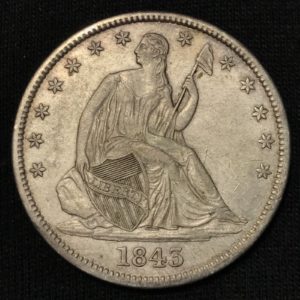
By 1839 Half Dollars had been in circulation for decades and had undergone a plethora of adjustments and 1839 proved no exception to this constant revising. In 1839, silver coins were overhauled yet again. Instead of the variations on the bust design that had been in circulation before, the new design featured a seated Liberty wearing a cap that signified freedom and a shield that represented preparedness. Like those before, this change…READ MORE
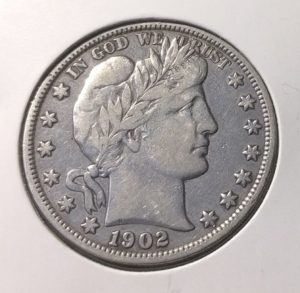
The Barber Half Dollar started with a contest. As the young United States cemented its identity, the US Mint looked for new designs for silver coinage to reflect the character of the fledgling nation. From the onset of this search for a new design, Chief Engraver Charles E. Barber wanted to assist in creating this new coinage but Mint Director James Kimball had other plans. Mr. Kimball wanted a new design for silver coins and he devised a plan to achieve this goal that did not include relying on Barber. His plan was…READ MORE
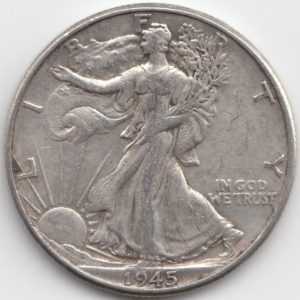
The Walking Liberty Half Dollar was a symbol of change in the second half of the 20th century. It was the time of Woodrow Wilson’s narrow re-election as President of the USA, the rise of movie theaters, and major shifts and changes in the world of technology. In this era of rapid change, it was bound to happen that the world of coins would undergo a serious transformation too. Here are some of the major distinguishing qualities of the Walking Liberty…READ MORE
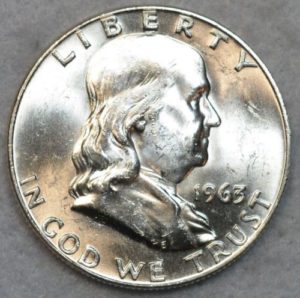
The Franklin Half Dollar is of enormous historical significance to American currency. Issued only a few years after WWII and at the beginning stages of the Cold War, this half dollar completed the transition of coin designs away from symbolic figures and artwork to actual historical figures. It was, in effect, the end of an era that has often been called the Golden Age of American coinage…READ MORE
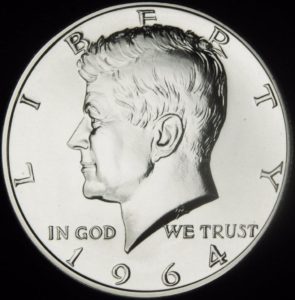
The Kennedy Half Dollar – In 1963, one of the most tragic events in American history occurred: President Kennedy was assassinated. It was a major crisis for the public’s consciousness and to this day most people who were alive at the time can tell you exactly what they were doing when they learned of the news. Due to President Kennedy’s extraordinary impact on the spirit of the American nation, it only makes sense that his legacy be engraved in a US coin…READ MORE
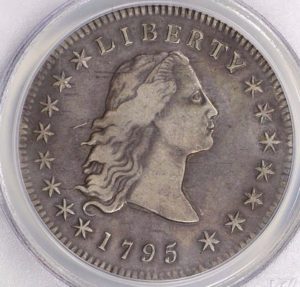
Early Silver Dollars – Flowing Hair and Draped Bust Silver Dollars (1794-1804). Early on, the dollar was decided by Congress to be the cornerstone of the US monetary system. Some of the earliest dollar designs included the Flowing Hair, Capped Bust, and Draped Bust silver dollars. These silver dollars were the foundation of both modern American coins and the collections of those who are fascinated by them. The first of their kind was the Flowing Hair, which was first minted in 1794 and remains historically important as the first American silver dollar…READ MORE
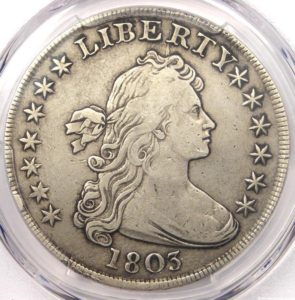
Early Silver Dollars – Flowing Hair and Draped Bust Silver Dollars (1794-1804). Early on, the dollar was decided by Congress to be the cornerstone of the US monetary system. Some of the earliest dollar designs included the Flowing Hair, Capped Bust, and Draped Bust silver dollars. These silver dollars were the foundation of both modern American coins and the collections of those who are fascinated by them. The first of their kind was the Flowing Hair, which was first minted in 1794 and remains historically important as the first American silver dollar…READ MORE
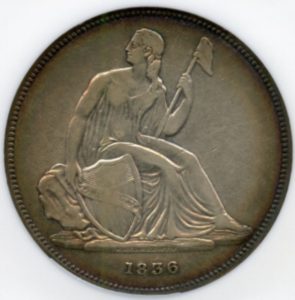
Since production of the silver dollar was stopped in 1806, the Gobrecht Dollar was circulated by the United States Mint, minted from 1836 to 1839. It was originally struck in small quantities, to see how the public would receive the reintroduction. It was due to the efforts of Mint directors Robert M. Patterson and…READ MORE
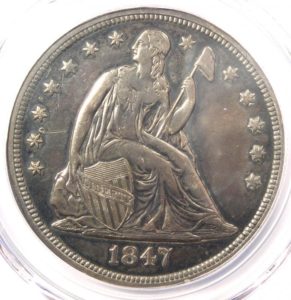
In 1840, Martin Van Buren was in the middle of serving a Presidential term through severe economic despair. Fittingly referred to as ‘the hard times,’ this era saw the growth of banks, unregulated at the time, issuing unsecured paper money. The era was strenuous and rough for many, seeing a vast majority unemployed and living in squalor…READ MORE
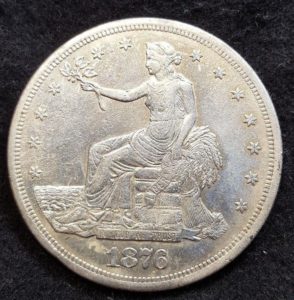
Trade Dollars remind us of a time when the Country faced a strange dilemma after the civil war. Although large amounts of silver were being produced in the mines, the Government were only able to use limited quantities. After the hoarding during the war, Mint Officials worried that the public would start hoarding an influx of new silver coins, too…READ MORE
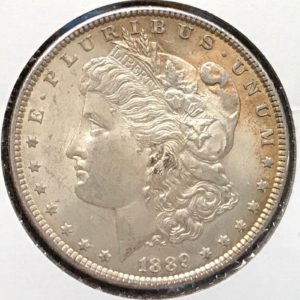
There is no other United states silver coin can compare with the rich history enjoyed by the Morgan silver dollar. Morgan silver dollar was designed by George T. Morgan, and it remains a favorite of both casual and serious coin collectors. A total of five U. S. Mints were involved in the production…READ MORE
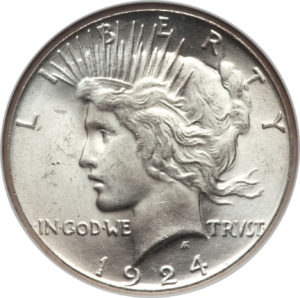
The Peace Dollar represents American ideals as the country began to assert itself on the world stage. The peace dollar was struck by the US Mint during a seven-year period, from 1921-1928, followed by a two-year mintage in 1934-1935.The Silver Peace Dollar coin succeeded the Morgan dollar which was minted last in 1921. Created to celebrate America’s victory in World War I, these Silver coins helped…READ MORE
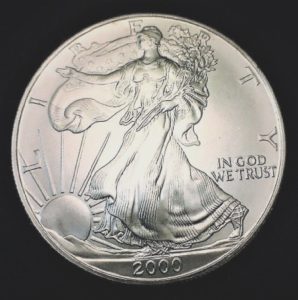
More than 200 million American Silver Eagles have been struck since the American Silver Eagle was first issued in 1986. As the year is considered the inauguration of the series, the Silver Eagles struck in 1986 remained popular with collectors. In this year, the US began striking silver and gold bullion coins in order to compete with the world bullion coins. Their value was supposed to be tied directly to the value of the metal used but, in cases where mintages are low, collector markets were developed…READ MORE
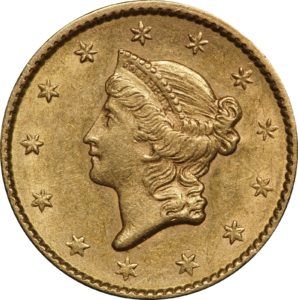
The gold dollar, historically known as been the smallest coin in the U.S., may be tiny in size, but it’s certainly made a significant stamp on collectors for its worth and rarity. Produced in Georgia and the Carolinas, the gold dollar was the result of two huge gold rushes, the first one taking place in the 1800’s. Impacting positively from the gold rush, two branch Mints were established in North Carolina and Georgia. This led to a distinctive increase in the Government producing gold coins…READ MORE
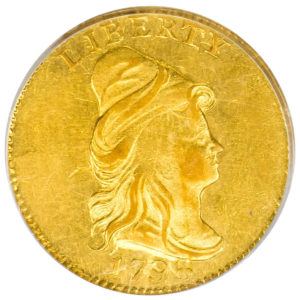
Early Quarter Eagles – Draped Bust and Capped Bust Gold $2.50 Quarter Eagles (1796-1834). The 1796 Draped Bust was the first quarter eagle and was designed by Chief Engraver Robert Scot. It depicts a figure of Lady Liberty wearing a cap with the inscription of ‘LIBERTY’ above and the date below. On the reverse side of the coin is the traditional American eagle surrounded by stars and ‘UNITED STATES OF AMERICA’…READ MORE
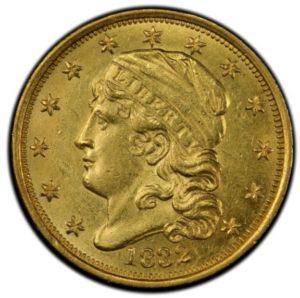
Early Quarter Eagles – Draped Bust and Capped Bust Gold $2.50 Quarter Eagles (1796-1834). The 1796 Draped Bust was the first quarter eagle and was designed by Chief Engraver Robert Scot. It depicts a figure of Lady Liberty wearing a cap with the inscription of ‘LIBERTY’ above and the date below. On the reverse side of the coin is the traditional American eagle surrounded by stars and ‘UNITED STATES OF AMERICA’…READ MORE
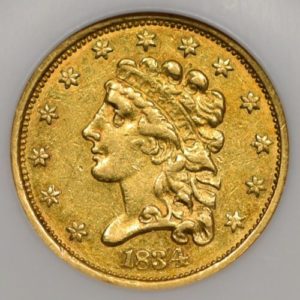
In the 1830’s, there was a serious crisis with America’s gold coin circulation. A short while after US Congress established an official ratio for bimetallic coins at ratio of 15:1 silver to gold, the price of gold steadily raised all over the world. As a result, speculators would buy up American coins and export them to the European nations, netting huge profits. These coins were often melted down in Europe to increase the wealth and spending power of the purchasers…READ MORE
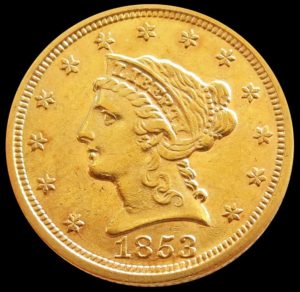
Starting in 1934, the US government tried to find a suitable design for their gold coins. Then, in 1838, Christian Gobrecht’s Coronet created a design for the Gold Quarter Eagle which was to remain and be used starting in 1840 all the way to 1907. The coin features a figure of Liberty on the front and wearing a coronet on which…READ MORE
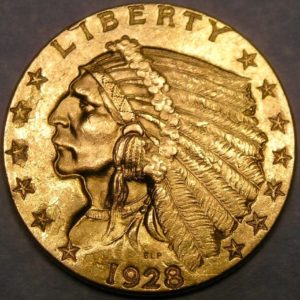
When the 20th century began, the design for the four gold coins that were then being made by the US government had been the same for fifty years. Many felt that this was a sign of a need for change and improvement. In 1901, Theodore Roosevelt agreed. Ever a proponent of and strong trigger for change, Roosevelt believed that an update to the gold coins of the US were far past due…READ MORE
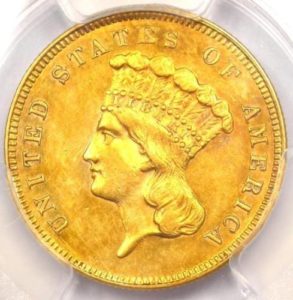
The Gadsden Purchase of 1853, unbeknowingly to all involved, set the scene for the Three Dollar Gold $3 of 1854. Due to its expanding borders and increasingly spread-out and sophisticated trading system, there was a demand for a universal and standard rate for US postage stamps. Congress ultimately made this demand a reality in 1854. As a result of this new system, the US government decided to create a three dollar gold coin in order to speed up…READ MORE
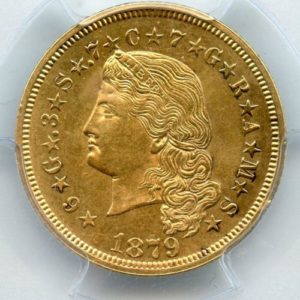
At the beginning of the 19th century, America was a country filled to the brim with expansionist and global sentiments. Toward the second half of the century, now securing its borders, this sentiment shifted its focus to international trade. This brought the burgeoning democracy into what was at the time something of a global crisis in trade: too many competing coins. By 1867 there was a widespread demand for a single world coin standard and it was in this year that twenty…READ MORE
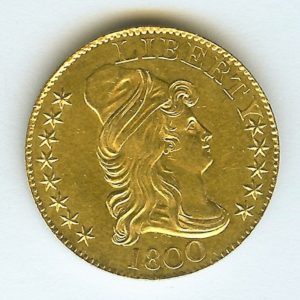
In American coinage, the half eagles or $5 pieces include some of the greatest rarities, with 1822 $5 being particularly famous. The denomination was produced intermittently from 1795 to 1929. But the initial series that was later known as the Draped Bust Half Eagles continued to be minted until 1807 in two different subtypes. Those were the Draped Bust, Small Eagle (1795-1798) and Draped Bust, Heraldic Eagle (1795-1807)…READ MORE
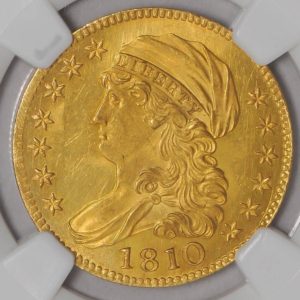
Also known as Capped Bust to Left, the Capped Bust Half Eagle is the second series of gold coins in $5 denomination within the United States. Produced from 1807 to 1834, it can be distinguished by a common reverse design and two different obverse designs. With the exception of 1816 and 1817, the coins were struck for circulation for each year…READ MORE
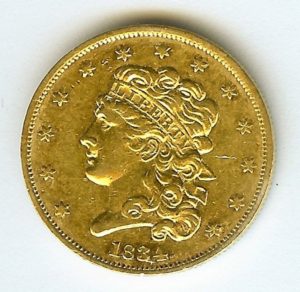
Excited about getting new gold coins into circulation, US Mint Director Samuel Moore asked Engraver William Kneass to create a new design. Kneass settled for a Liberty with tousled hair and facing her left. She had a headband with the words LIBERTY inscribed on it. The date was placed below the head, which was circled by 13 stars…READ MORE
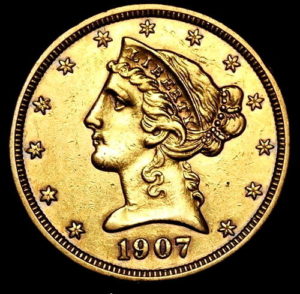
The US half eagle gold coin went through several designs throughout its run. Robert Scot’s design kicked off the series in 1795. It was followed by the Draped Bust design by John Reich in 1807. The Classic Head design by William Kneass was released in 1834, which was then replaced by Christian Gobrecht’s Liberty Head design in 1839. A final type, the Indian Head by Bela Lyon Pratt, was produced in 1908 and ended in 1929 with a break in production during the First World War…READ MORE
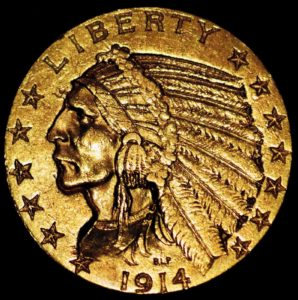
Theodore Roosevelt, who served as US president from 1901 to 1909, welcomed new ideas. He was interested in many areas concerning the nation, including coinage design. Roosevelt asked Augustus Saint-Gaudens, the foremost sculptor at the time, to redesign the double eagle and the eagle. The new designs debuted in 1907 to great reviews, and on the heels of that success, Roosevelt sought on…READ MORE
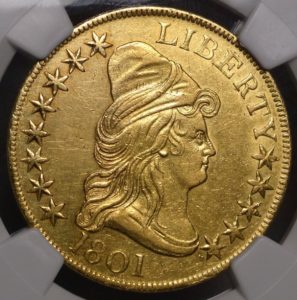
During the 18th century, Americans were only familiar with the Spanish Coins when talking about the United States’ monetary systems after the Revolutionary War. In a bid to strike a balance between the old and new, the architects of the monetary system formulated a plan to do just that. This resulted in a new coinage scheme for the $10 piece that was the country’s premier gold coin. Because it was intended to be America’s face to the world by the Congress Mint Act of 1792, the “eagle” was symbolically added, which is the US’ national bird…READ MORE
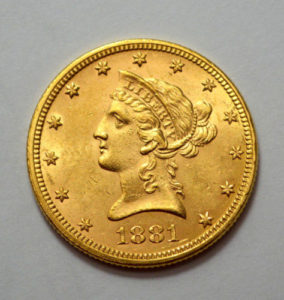
The $10 Liberty Head Gold Eagle is reminiscent of a time when the monetary system was based on denominations of the metal value attached to them. As a result, the US followed in line with European practices in governing their monies by which precious metal they were made of. The ‘Eagle’ was a gold coin and was considered a standard denomination of such right…READ MORE
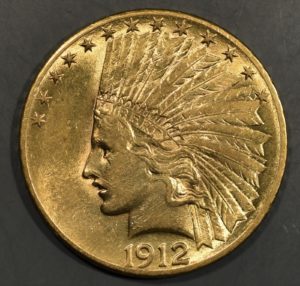
Artistic and U.S. coinage were two words that hardly ever appeared in the same sentence. It was an image President Theodore Roosevelt was determined to change with his sweeping coinage design legislation. One of the first examples produced from this change was the $10 Indian Head Gold Eagle designed by Augustus Saint-Gaudens and produced from 1907 to…READ MORE
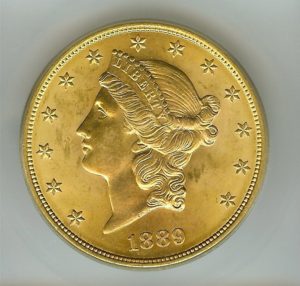
Also known as the Coronet double eagle, the American twenty-dollar gold piece was used in 1849 as a pattern coin and from 1850 to 1907 for commerce. It owes its design from the mind of James B. Longacre, the then Chief Engraver of Mint of the United States. Along with the gold dollar, the double eagle was a direct result of the Congress considering new denominations of gold coinage…READ MORE
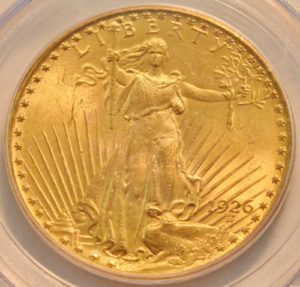
Gold coins signify opulence, and with good reason. Gold is perhaps one of the most easily recognized precious metals. Long before the age of credit cards or even paper currency, it was gold that symbolized wealth. In the early 1900’s, President Theodore Roosevelt inquired of sculptor…READ MORE
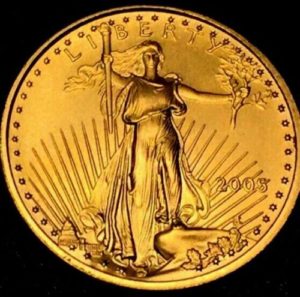
Among the modern US Mint issues, the gold bullion is one of the most popular – especially American Gold Eagles. Although 1986 was the inaugural year, the sale of the coins did not start until October of the same year. Still, the annual total for that year was the highest on record and remained the same until 1998. The bullion coins are offered in different sizes–1 oz, 1/2 oz, 1/4 oz, and 1/10 oz…READ MORE
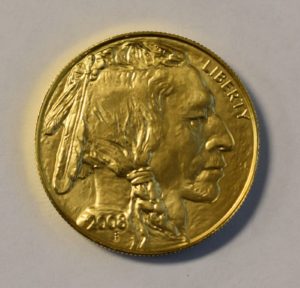
One is made of 24-karat gold while the other looks like a medallion, but both are gold coins that have been produced in the US. The American Buffalo or gold buffalo has been produced each year since 2006 while the gold high reliefs have been minted twice: 2009 and 2015…READ MORE
When it came to minting coins in Spanish America, platinum was the metal of choice. It was usually mixed with gold, a practice that was adopted in mainland Spain. The British Royal Mint also tried to see if they could use platinum coins as currency in the late 1820s. Only Russia, between 1828 and 1845, was able to use platinum coins as a regular national currency. Platinum as a metal of choice for coins is not…READ MORE
Submit for Appraisal & Offer
For the easiest free appraisal and best offers we suggest Coinfully, drop an image or list below!
Copyright © 2023 Sell Coins Near Me.